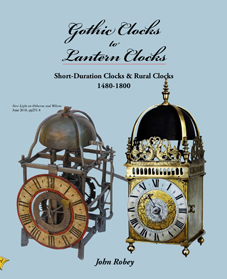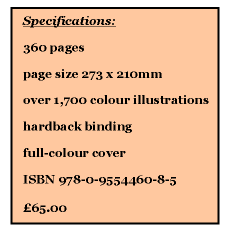

Gothic Clocks to Lantern Clocks
Short Duration Clocks & Rural Clocks 1480-1800
by John A. Robey
The earliest mechanical clocks were installedin the towers of European churches and otherpublic buildings, often with more emphasis onastronomical displays than timekeeping. By thefourteenth century small clocks for domestic usebecame more widespread, initially being simpletimepieces or alarms. These developed into elaborateiron clocks based on Gothic styles of architecture,with painted iron dials, and usually striking thehour on a bell, or even striking the quarter hours onan additional bell.These clocks were bought by the wealthythroughout Europe, including Britain, but by thestart of the seventeenth-century English clockmakersdeveloped the lantern clock, made mostly of brasswith engraved dials, to replace Continental ironclocks, which had become regarded as old fashionedand unreliable. The focus of clockmaking thenshifted from Germany to England.Iron clocks were still made, especially for the lesswell-to-do, and continued as rural clocks until theearly nineteenth century. While Gothic clocks andearly lantern clocks are widely studied and collected,less attention has been paid to later rural and shortdurationclocks, with little information in print.Gothic Clocks to Lantern Clocks aims to remedythis by discussing a wide range of clocks, many ofthem being unique examples or having unusualand interesting features, many of which are quitedifferent to those on English clocks. Since they aremostly unsigned, regional technical characteristicshave to be used to establish their origins, and thereis much emphasis on constructional and technicalfeatures, while not neglecting the design of theirdials.An introductory chapter discusses the three maintypes of Gothic clock, details and variations of stripframes and posted frames, wheels, hour and quarterstriking, bells and dials. Five chapters describe andillustrate twenty-six Germanic clocks, ten Italianclocks, fourteen French and Flemish clocks, fourteenEnglish clocks and four Swedish clocks. Each hasup to thirty colour illustrations, as well as wheelcounts and dimensions. Restorations, reproductions,replicas and fakes are also discussed, followed bysix appendices, an annotated bibliography and anindex.With over 1,700 full-colour illustrations, mainlytaken by the author, and with much technical andother information never before published, this booksets a new standard in horological publishing.
ContentsChapter 1 Introduction to Short-Duration Clocks & Rural Clocks
Chapter 2 Germanic Clocks
Chapter 3 Italian Iron Clocks & Lantern Clocks
Chapter 4 Iron Clocks & Lantern Clocks from France
& the Low Countries
Chapter 5 English Lantern Clocks & Thirty-Hour Clocks
Chapter 6 Swedish Iron Clocks
Chapter 7 Modernizations, Restorations, Reproductions & Fakes
Appendix A Early Horological Illustrations
Appendix B The Invention of Warned Striking
Appendix C English Lantern Clocks with an Original Balance
Appendix D An Italian Treatise on Clocks, 1665
Appendix E Going Train & Striking Train Calculations
Appendix F Faces of Time
Annotated Bibliography
Index
An introductory chapter includes the development of the earliest clocks,
Germanic, French and Burgundian Gothic clocks, strip frames, posted
frames, wheels, strike-work, dials and bells. Chapters 2-6 include full
details and numerous full-colour illustrations of 26 Germanic clocks,
10 Italian clocks, 14 French and Flemish clocks, 14 English clocks and
4 Swedish clocks. Many examples are unusual or unique.
The author
John Robeystudied physics at Leeds University and research at Sheffield University, thenthen worked in the electrical power industry, before moving into nonfiction publishing.
An interest in the history of technology led to research and publications on the early use of steam power in Britain, the Peak District’s lead mines, and the copper and brass industries. Horology combines his interests in history, technology and restoration, with his training as a scientist.
He divides his time between publishing books on horological subjects and restoring clocks — particularly those with interesting mechanisms. He has written numerous articles in Antiquarian Horology, Horological Journal and Clocks magazine.
He was awarded the British Horological Institute’s 2007 Barratt Silver Medal for his contributions to horological research, writing and publishing.
